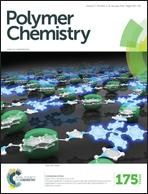Amine–imine palladium catalysts for living polymerization of ethylene and copolymerization of ethylene with methyl acrylate: incorporation of acrylate units into the main chain and branch end†
Abstract
Neutral and cationic palladium complexes bearing an amine–imine ligand with different donor functionalities have been synthesized and characterized. Cationic amine–imine palladium complexes can be directly employed in the homopolymerization of ethylene and the copolymerization of ethylene and methyl acrylate (MA) without any cocatalysts. A thermally stable amine–imine palladium catalyst with two bulky 2,6-diisopropyl substituents can catalyze ethylene polymerization in a living fashion at 25 °C to afford branched polyethylene. The copolymerization of ethylene and MA using a bulky amine–imine palladium catalyst affords branched copolymers with a 3-fold increased incorporation of MA relative to those obtained by an α-diimine palladium analogue. Both direct incorporation of an acrylate unit into the main chain and migratory incorporation of the terminal acrylate unit can be observed.


 Please wait while we load your content...
Please wait while we load your content...